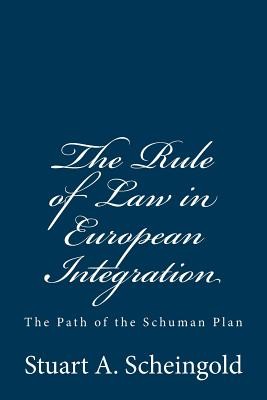
- We will send in 10–14 business days.
- Publisher: Quid Pro LLC
- Year: 2013
- Pages: 244
- ISBN-10: 1610272013
- ISBN-13: 9781610272018
- Format: 15.6 x 23.4 x 1.3 cm, minkšti viršeliai
- Language: English
- SAVE -10% with code: EXTRA
The Rule of Law in European Integration (e-book) (used book) | bookbook.eu
Reviews
Description
This pathbreaking book "remains the definitive analysis of the first crucial decade of the formulation of the Constitution of Europe by at the time a little-known court. It must be read by all serious scholars of European integration." - Malcolm M. Feeley (University of California at Berkeley), from the new Foreword. In the early days of what would become the European Union, the new entity had a weak and ill-defined legislature and executive. And the European Court of Justice, whose decisions, actions, and even inactions subtly paved the way to a continent's integration. "Scheingold showed that its efforts, deftly melding law and politics, were a success beyond mere dispute-resolution and development of legal doctrine," writes Feeley in the new introduction to this classic study. "He was well aware that he was present at the creation of a powerful new institution. Yet he stood virtually alone in seeing what such an institution, using its power this way, could realize in terms of political integration. The resulting book was a masterpiece." The formative years of the EU relied on consensus and legal processes, and an emerging, agile Court-but not on the predictable analogy to federalization as in U.S. Constitutional law-to evolve integration and respect for a higher authority than national law. Scheingold reveals these insights by examining political activity with his in-the-trenches research more than by the customary analysis of doctrine. Presented in a new, affordable printing with modern formatting and the new Foreword, the book is part of the Classics of Law & Society Series from Quid Pro Books. It embeds the original pagination, to enhance referencing and citations from previous printings and to allow continuity with the new digital edition.
EXTRA 10 % discount with code: EXTRA
The promotion ends in 23d.08:26:36
The discount code is valid when purchasing from 10 €. Discounts do not stack.
- Publisher: Quid Pro LLC
- Year: 2013
- Pages: 244
- ISBN-10: 1610272013
- ISBN-13: 9781610272018
- Format: 15.6 x 23.4 x 1.3 cm, minkšti viršeliai
- Language: English English
This pathbreaking book "remains the definitive analysis of the first crucial decade of the formulation of the Constitution of Europe by at the time a little-known court. It must be read by all serious scholars of European integration." - Malcolm M. Feeley (University of California at Berkeley), from the new Foreword. In the early days of what would become the European Union, the new entity had a weak and ill-defined legislature and executive. And the European Court of Justice, whose decisions, actions, and even inactions subtly paved the way to a continent's integration. "Scheingold showed that its efforts, deftly melding law and politics, were a success beyond mere dispute-resolution and development of legal doctrine," writes Feeley in the new introduction to this classic study. "He was well aware that he was present at the creation of a powerful new institution. Yet he stood virtually alone in seeing what such an institution, using its power this way, could realize in terms of political integration. The resulting book was a masterpiece." The formative years of the EU relied on consensus and legal processes, and an emerging, agile Court-but not on the predictable analogy to federalization as in U.S. Constitutional law-to evolve integration and respect for a higher authority than national law. Scheingold reveals these insights by examining political activity with his in-the-trenches research more than by the customary analysis of doctrine. Presented in a new, affordable printing with modern formatting and the new Foreword, the book is part of the Classics of Law & Society Series from Quid Pro Books. It embeds the original pagination, to enhance referencing and citations from previous printings and to allow continuity with the new digital edition.


Reviews